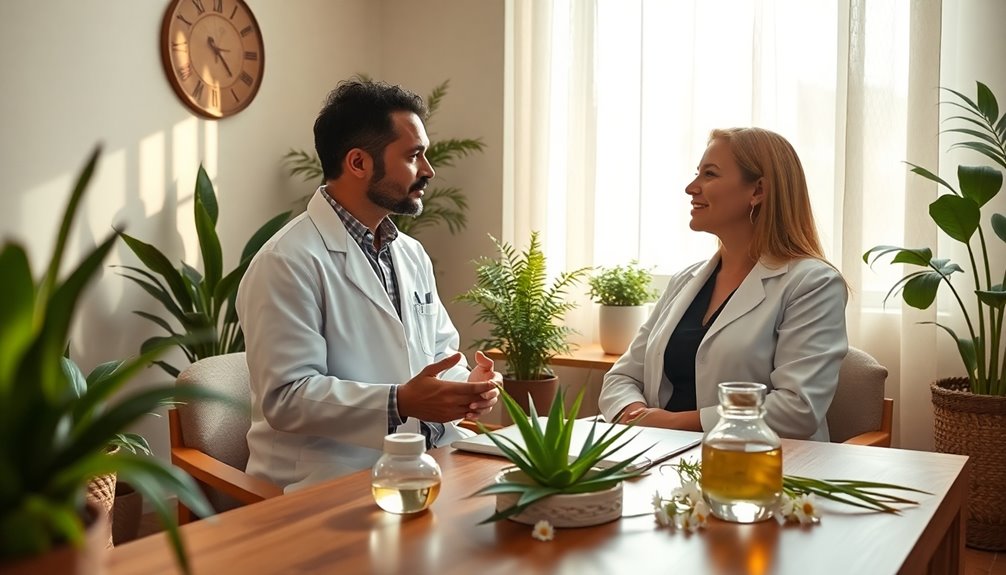To naturally reduce redness in your skin, try soothing remedies like aloe vera gel and cooling cucumber masks. Applying chamomile tea with a washcloth can also help calm inflammation. Incorporate gentle skincare products with anti-redness properties and maintain a diet rich in cooling foods such as spinach. It's important to manage stress and protect your skin from sun damage. If you're curious about more tips and products to help improve your complexion, keep exploring!
Key Takeaways
- Apply grated cucumber or a cucumber mask for 30 minutes to cool and soothe irritated skin.
- Use colloidal oatmeal masks for 10 minutes to harness anti-inflammatory benefits and reduce redness.
- Apply cooled chamomile tea with a washcloth to alleviate redness and inflammation effectively.
- Incorporate antioxidant-rich green tea into your skincare routine to promote skin health and minimize redness.
- Use aloe vera gel to moisturize and calm irritated skin, leveraging its natural anti-inflammatory properties.
Soothing Household Remedies

When your skin feels irritated and red, you might want to reach for some soothing household remedies that can help calm it down.
Cucumber masks are great; grating fresh cucumber and applying it for 30 minutes can provide a cooling effect. Additionally, using glycolic acid in your skincare routine can help improve overall skin texture and tone, complementing the soothing effects of cucumber.
Oatmeal, especially colloidal oatmeal, offers anti-inflammatory benefits when used as a mask for 10 minutes, soothing irritated skin. This can be particularly effective for those with sensitive skin prone to redness.
Colloidal oatmeal masks provide soothing anti-inflammatory benefits, calming irritated skin in just 10 minutes.
You can also apply cooled chamomile tea with a washcloth, taking advantage of its calming properties to alleviate redness. This natural remedy is gentle and helps reduce inflammation without irritating the skin further.
Steeping green tea and applying it can promote overall skin health while potentially reducing redness. The antioxidants in green tea may also support your skin's natural healing processes.
Finally, don't forget aloe vera; applying its gel directly can soothe and moisturize to calm irritated skin effectively. Additionally, incorporating anti-inflammatory benefits from various natural ingredients can enhance the effectiveness of your skincare routine.
These natural remedies can be a game-changer for skin redness.
Effective Anti-Redness Skincare Products

Finding the right skincare products can make a significant difference in managing redness and irritation. Effective anti-redness skincare products like Intellishade and CE Ferulic offer soothing properties that protect your skin from environmental stressors. Additionally, products with glycolic acid can help improve skin tone and clarity, which may further assist in reducing redness over time. For targeted relief, try calming options like Colorescience All Calm, specifically designed to reduce facial redness. Nourishing anti-aging products, such as NeoCutis Bio Serum Firm, not only improve texture but also help minimize redness over time. Additionally, consider incorporating hydrocolloid patches into your routine, as they can provide localized treatment for blemishes while promoting healing.
To maximize results, incorporate these products consistently into your skincare routine, as their efficacy increases with regular use. Ultimately, don't hesitate to consult a dermatologist for personalized recommendations, ensuring you select the best anti-redness solutions tailored to your unique skin needs.
Natural Treatments for Rosacea

If you're struggling with rosacea, natural treatments can offer effective relief without harsh chemicals. Aloe vera gel is a fantastic option, thanks to its anti-inflammatory properties; simply apply it directly to your skin to help soothe redness. Additionally, incorporating foods high in dietary fiber can support overall gut health, which may influence skin conditions.
Chamomile is another great choice; whether you use it as a cooled tea or a diluted essential oil, it can alleviate your symptoms. Try incorporating burdock root in tea or extract form to improve circulation and provide antioxidants for better skin health.
Don't forget to include cooling foods like cucumber and spinach in your diet while cutting down on alcohol and spicy items to help reduce flare-ups. Finally, applying green tea topically can enhance your skin's health and greatly reduce redness. Additionally, using essential oils for hair growth can support overall skin health due to their natural properties.
Lifestyle Changes to Minimize Redness

Natural treatments can provide immediate relief for rosacea, but making lifestyle changes can help minimize redness in the long run. Here are some effective strategies to take into account:
- Incorporate cooling foods: Add cucumber, celery, and spinach to your diet for their anti-inflammatory properties to reduce skin redness.
- Maintain a consistent skincare routine: Use gentle, non-irritating products to strengthen your skin barrier and reduce susceptibility to redness.
- Practice stress management: Engage in techniques like deep breathing or yoga to prevent emotional triggers that lead to facial flushing.
- Limit alcohol and spicy foods: Reducing these known triggers can help maintain clearer skin and minimize redness over time. Additionally, a diet rich in antioxidants that combat oxidative stress can support overall skin health and reduce inflammation.
Also, don't forget to apply broad-spectrum sunscreen daily to protect your skin from UV damage!
The Role of Professional Dermatological Advice

While you might try various home remedies to manage skin redness, consulting a dermatologist can provide invaluable insights tailored to your specific needs. Professional dermatologists can help you identify the causes of facial redness, such as allergic reactions or underlying conditions like rosacea. They'll recommend effective skincare ingredients to soothe the skin and reduce the appearance of redness, including dilution guidelines for any essential oils you may use. Regular visits allow them to monitor skin conditions and adjust your treatment plan as necessary. Additionally, incorporating natural remedies like aloe vera juice may provide soothing benefits for irritated skin.
| Benefits of Dermatological Advice | Key Actions |
|---|---|
| Tailored treatment for skin types | Identify triggers |
| Recommended calming agents | Perform patch tests |
| Ongoing evaluations | Adjust treatment strategies |
Frequently Asked Questions
How to Quickly Reduce Skin Redness?
To quickly reduce skin redness, try applying a cool compress or chilled green tea bags directly to the affected area. This constricts blood vessels and offers immediate relief.
You can also whip up a soothing mask using grated cucumber or oatmeal; leave it on for about 10 minutes before rinsing.
Incorporating gentle, non-irritating cleansers and moisturizers into your routine can help maintain your skin's barrier, preventing further irritation.
What Vitamin Gets Rid of Red Skin?
You might be wondering which vitamin can help get rid of that pesky red skin, right?
Well, niacinamide, or Vitamin B3, is your go-to option. It not only reduces redness but also improves your skin's barrier function.
Plus, Vitamin C brightens your complexion and tackles inflammation, while Vitamin E soothes irritation.
If you're serious about calming your skin, incorporating these vitamins into your routine could make a noticeable difference.
What Reduces Redness of Inflamed Skin?
To reduce redness of inflamed skin, you can try several effective remedies.
Applying cooled chamomile or green tea bags directly to your skin can soothe irritation. You might also consider using aloe vera gel for its anti-inflammatory properties.
Oatmeal masks are great too; just leave them on for about 10 minutes.
Finally, incorporating cooling foods like cucumber and spinach into your diet can help manage redness over time.
What Active Reduces Redness?
Have you ever wondered why your skin sometimes looks flushed? Certain actives can help reduce that redness.
Ingredients like niacinamide strengthen your skin barrier and calm inflammation, while green tea extract packs antioxidants that soothe irritation.
Aloe vera gel is another great choice, known for its anti-inflammatory properties.
Don't forget about chamomile and colloidal oatmeal, which also effectively alleviate redness and provide a natural, calming touch to your skincare routine.
Conclusion
So, there you have it! With a few household remedies, some fancy skincare products, and maybe a dash of mindfulness, you can transform into a glowing skincare guru. Who needs a professional when you've got a cucumber and an internet connection, right? Just remember, if your skin's still throwing a tantrum after all that, it might be time to ditch the DIY approach and let a dermatologist work their magic. After all, even skin deserves a little pampering!










